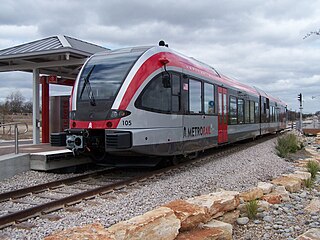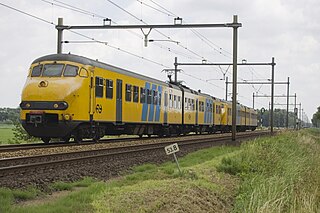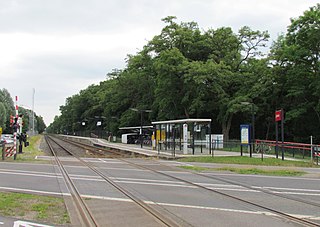
Bredevoort is a small city with city privileges of about 1600 inhabitants in the municipality of Aalten, Netherlands. It is between the towns of Aalten and Winterswijk.

The Stadler GTW is an articulated railcar for local transport made by Stadler Rail of Switzerland. GTW stands for Gelenktriebwagen.

Rail transport in the Netherlands uses a dense railway network which connects nearly all major towns and cities. There are as many train stations as there are municipalities in the Netherlands. The network totals 3,223 route km (2,003 mi) on 6,830 kilometres (4,240 mi) of track; a line may run both ways, or two lines may run on major routes. Three-quarters of the lines have been electrified.

The Blue Angel was the name given to the Plan X class DE-1 and DE-2 diesel railcars formerly used by Nederlandse Spoorwegen. There have been rumours that the name has a connection to the German movie Der blaue Engel, but this has never been confirmed.

Apeldoorn railway station is a railway station in Apeldoorn, Netherlands. The station was opened on 15 May 1876, on the Amsterdam–Zutphen railway. It was opened when the Amersfoort to Zutphen section was completed.

Amersfoort Centraal is the main railway station in Amersfoort in the province of Utrecht, Netherlands. The station was an important link between the western part of the Netherlands and the north and east of the country until December 2012 when the Hanzelijn opened.

Arnhem Centraal railway station is the largest railway station in the city of Arnhem in Gelderland, Netherlands. It was opened on 14 May 1845 and is located on the Amsterdam–Arnhem railway, the Arnhem–Leeuwarden railway and the Arnhem–Nijmegen railway. The station opened at the same time as the Amsterdam–Arnhem railway, that continues into Germany via the Oberhausen–Arnhem railway.

Deventer is a railway station in Deventer, Netherlands. The station was opened on 5 August 1865 and is on the Apeldoorn–Deventer railway, Deventer–Almelo railway and the Arnhem–Leeuwarden railway. The train services are operated by Nederlandse Spoorwegen.

The NS Mat '64 or Materieel '64 were electric multiple units (EMU) built by Werkspoor and later by Duewag and Waggonfabrik Talbot between 1961 and 1976. They were operated in the Netherlands by the Nederlandse Spoorwegen (NS) until 2016. The equipment consisted of independent four and two-car train sets called Plan T and Plan V: the Plan T is a 4-car EMU, and the Plan V is a 2-car EMU. Materieel '64 is sometimes nicknamed 'Apekoppen' and 'Standaard Stoptrein' due to their distinct shape.

Klarenbeek is a railway station, located in Klarenbeek, Netherlands. The station opened on 1 June 1882 and is on the Amsterdam–Zutphen railway (Oosterspoorweg). The station is actually 2 km north-east of Klarenbeek. The station was originally only built because the line between Apeldoorn and Zutphen was single track, a passing point was needed, this was here. Until December 2006, the station had just 1 platform and one train each way per hour stopped at the station, allowing the other to pass. In December 2006, when 2 more new stations were built on the line, the station received 2 platforms. The train services are operated by Arriva.

Almelo is a railway station in Almelo, Netherlands. The station was opened on 18 October 1865 and is on the Deventer–Almelo railway, Almelo–Salzbergen railway, Zwolle–Almelo railway and Mariënberg–Almelo railway lines. The current station building dates from 1962. The train services are operated by Nederlandse Spoorwegen and Arriva.

The Arnhem–Leeuwarden railway is a railway line in the Netherlands running from Arnhem to Leeuwarden, passing through Deventer, Zwolle and Heerenveen. It is also called the Staatslijn A in Dutch. The part between Arnhem and Zwolle is sometimes called the IJssellijn.

The Almelo–Salzbergen railway is a both Dutch and German 54 kilometre long railway line, that connects Almelo with Salzbergen, offering a rail link between the Netherlands and Germany.

The Apeldoorn–Zwolle railway was a railway in the Netherlands connecting Apeldoorn, Gelderland with Zwolle, Overijssel. The railway was constructed by the Royal Netherlands Railway Company and opened between 1887 and 1889. The railway soon earned the nickname Baron Line, thanks to the number of nobles living along the line. The railway was closed in 1950 and largely dismantled in the 1970s.

The Winterswijk – Zevenaar railway is a 49-kilometre-long (30 mi) Dutch regional railway line, that connects Arnhem and Zevenaar with Doetinchem and Winterswijk.

The NS 3400 was a series of goods steam locomotives of the Dutch Railways (NS), ordered by its predecessor the Hollandsche IJzeren Spoorweg-Maatschappij (HSM).

The NS 7700 was a series of tank engines of the Dutch Railways (NS) and its predecessor the Hollandsche IJzeren Spoorweg-Maatschappij (HSM).

Düwag Wadloper is a family of diesel railcars and diesel multiple units produced by the German Düwag plant in Düsseldorf. Between 1981 and 1983, a total of 50 vehicles of this kind were built specifically for the Dutch Nederlandse Spoorwegen railroad. At the beginning of the 21st century, they were mainly operated by private carriers; in 2006 they began to be phased out, and in 2008 they were sold to other countries. The trains went to carriers from Poland, Argentina and Romania. They were operated by Przewozy Regionalne, Masovian Railways and Koleje Śląskie, and also used by Trenes de Buenos Aires to operate a cross-border service between Argentina and Uruguay. They currently operate services connecting Argentina with Paraguay, and are operated in Poland by SKPL Cargo, as well as on several lines in Romania.






























